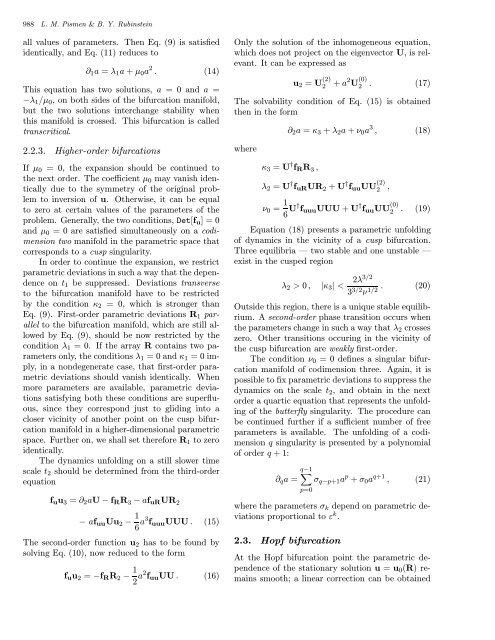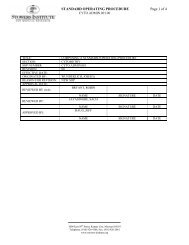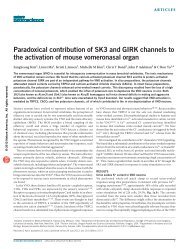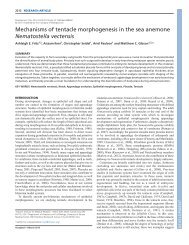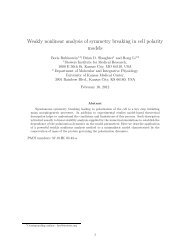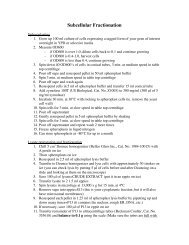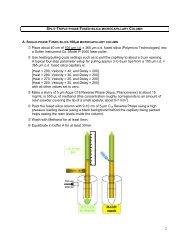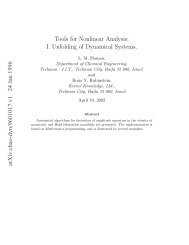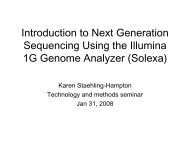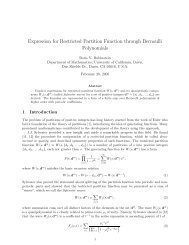Computer Tools for Bifurcation Analysis: General Approach with
Computer Tools for Bifurcation Analysis: General Approach with
Computer Tools for Bifurcation Analysis: General Approach with
Create successful ePaper yourself
Turn your PDF publications into a flip-book with our unique Google optimized e-Paper software.
988 L. M. Pismen & B. Y. Rubinstein<br />
all values of parameters. Then Eq. (9) is satisfied<br />
identically, and Eq. (11) reduces to<br />
∂ 1 a = λ 1 a + µ 0 a 2 . (14)<br />
This equation has two solutions, a =0anda=<br />
−λ 1 /µ 0 , on both sides of the bifurcation manifold,<br />
but the two solutions interchange stability when<br />
this manifold is crossed. This bifurcation is called<br />
transcritical.<br />
2.2.3. Higher-order bifurcations<br />
If µ 0 = 0, the expansion should be continued to<br />
the next order. The coefficient µ 0 may vanish identically<br />
due to the symmetry of the original problem<br />
to inversion of u. Otherwise, it can be equal<br />
to zero at certain values of the parameters of the<br />
problem. <strong>General</strong>ly, the two conditions, Det[f u ]=0<br />
and µ 0 = 0 are satisfied simultaneously on a codimension<br />
two manifold in the parametric space that<br />
corresponds to a cusp singularity.<br />
In order to continue the expansion, we restrict<br />
parametric deviations in such a way that the dependence<br />
on t 1 be suppressed. Deviations transverse<br />
to the bifurcation manifold have to be restricted<br />
by the condition κ 2 = 0, which is stronger than<br />
Eq. (9). First-order parametric deviations R 1 parallel<br />
to the bifurcation manifold, which are still allowed<br />
by Eq. (9), should be now restricted by the<br />
condition λ 1 = 0. If the array R contains two parameters<br />
only, the conditions λ 1 =0andκ 1 =0imply,<br />
in a nondegenerate case, that first-order parametric<br />
deviations should vanish identically. When<br />
more parameters are available, parametric deviations<br />
satisfying both these conditions are superfluous,<br />
since they correspond just to gliding into a<br />
closer vicinity of another point on the cusp bifurcation<br />
manifold in a higher-dimensional parametric<br />
space. Further on, we shall set there<strong>for</strong>e R 1 to zero<br />
identically.<br />
The dynamics unfolding on a still slower time<br />
scale t 2 should be determined from the third-order<br />
equation<br />
f u u 3 = ∂ 2 aU − f R R 3 − af uR UR 2<br />
− af uu Uu 2 − 1 6 a3 f uuu UUU . (15)<br />
The second-order function u 2 has to be found by<br />
solving Eq. (10), now reduced to the <strong>for</strong>m<br />
f u u 2 = −f R R 2 − 1 2 a2 f uu UU . (16)<br />
Only the solution of the inhomogeneous equation,<br />
which does not project on the eigenvector U, isrelevant.<br />
It can be expressed as<br />
u 2 = U (2)<br />
2 + a 2 U (0)<br />
2 . (17)<br />
The solvability condition of Eq. (15) is obtained<br />
then in the <strong>for</strong>m<br />
where<br />
∂ 2 a = κ 3 + λ 2 a + ν 0 a 3 , (18)<br />
κ 3 = U † f R R 3 ,<br />
λ 2 = U † f uR UR 2 + U † f uu UU (2)<br />
2 ,<br />
ν 0 = 1 6 U† f uuu UUU + U † f uu UU (0)<br />
2 . (19)<br />
Equation (18) presents a parametric unfolding<br />
of dynamics in the vicinity of a cusp bifurcation.<br />
Three equilibria — two stable and one unstable —<br />
exist in the cusped region<br />
λ 2 > 0 , |κ 3 | < 2λ3/2<br />
3 3/2 . (20)<br />
ν1/2 Outside this region, there is a unique stable equilibrium.<br />
A second-order phase transition occurs when<br />
the parameters change in such a way that λ 2 crosses<br />
zero. Other transitions occuring in the vicinity of<br />
the cusp bifurcation are weakly first-order.<br />
The condition ν 0 = 0 defines a singular bifurcation<br />
manifold of codimension three. Again, it is<br />
possible to fix parametric deviations to suppress the<br />
dynamics on the scale t 2 , and obtain in the next<br />
order a quartic equation that represents the unfolding<br />
of the butterfly singularity. The procedure can<br />
be continued further if a sufficient number of free<br />
parameters is available. The unfolding of a codimension<br />
q singularity is presented by a polynomial<br />
of order q +1:<br />
q−1<br />
∑<br />
∂ q a= σ q−p+1 a p + σ 0 a q+1 , (21)<br />
p=0<br />
where the parameters σ k depend on parametric deviations<br />
proportional to ε k .<br />
2.3. Hopf bifurcation<br />
At the Hopf bifurcation point the parametric dependence<br />
of the stationary solution u = u 0 (R) remains<br />
smooth; a linear correction can be obtained


